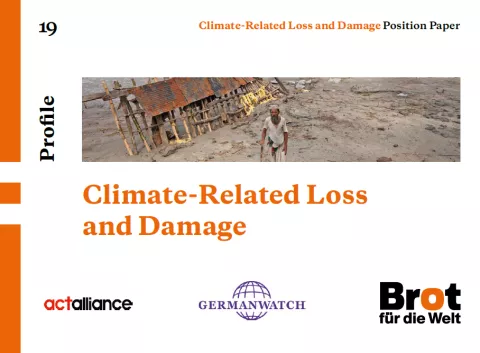
In August 2015 an unusually intense monsoon caused devastating floods and landslides leading to the death of many people across Asia. Particularly in Myanmar, the rain destroyed hundreds of thousands of homes and streets and flooded rice paddies. In its most recent report, the Intergovernmental Panel on Climate Change (IPCC) warns that climate change will increase the duration and intensity of such and similar extreme weather events (IPCC 2014b). This will also lead to an increase in climate- related loss and damage (L&D), either as a result of extreme weather events or associated with slow-onset climate change, when glaciers melt, permafrost thaws and sea levels rise.
The extent of adverse impacts will depend on two factors: successful emissions reductions and successful climate adaptation and climate risk management. These two aspects are at the heart of the 1992 United Nations Framework Convention on Climate Change (UNFCCC), which aims for a ‘stabilization of greenhouse gas concentrations in the atmosphere at a level that would prevent dangerous anthropogenic interference with the climate system’ (UNFCCC 1992). By inducing climate change, past and present emissions have already caused a certain degree of adverse impacts (see Warner/Zakieldeen 2012); cutting emissions alone, therefore, is not a sufficient response. In future, too, even if it was possible to reduce greenhouse gas emissions rapidly and significantly, it would not be possible to avoid the negative consequences of climate change completely. As our capacity to adapt to climate change is limited by natural, technical and economic constraints (see IPCC 2007, chapter 17.4.2), the result is L&D.
Estimates on the future geographic distribution and extent of L&D associated with climate change, based for example on IPCC climate models, remain highly uncertain. The first chapter of this publication therefore deals with current trends, scientific findings and risk factors.
Increasing numbers of people in particularly vulnerable regions such as Oceania, Southeast Asia, Central America and the southern Sahel are likely to be faced with unsolvable problems as a result of climate change. In Mali it is increasing droughts and in Kiribati rising sea levelsthat drive people to leave their homes. The second chapter therefore describes the minimal support they have received so far and pinpoints the political challenges.
However, climate-induced migration is not the only taboo issue. L&D related to climate change is generally a hard nut for international climate policy. Why this is so, where the lines of conflict run, the progress that has nonetheless been made, and what to expect for the future, are the questions discussed in the third chapter.
Alongside the international negotiations within the framework of the UNFCCC, there are further international policy panels within and outside of the UN dedicated to mitigating climate risks, improving insurance against L&D, providing protection to migrants and asserting human rights-based principles. Chapter four deals with these questions.
However, because international instruments have so far had very little impact, the affected countries are more or less left to themselves to deal with climate risks. How do the most vulnerable states cope with these challenges? What positive examples are there and what can we learn from these experiences? These are the questions chapter five analyses, with a special focus on the South Sea island nation of Fiji and the country of El Salvador in Central America.
After the initial chapters present the challenges related to increasing climate risks and analyse the capacity of current international and national instruments to provide solutions, the sixth chapter, in the form of an interim conclusion, considers the existing and potentially widening climate risk gap caused by the inability of approaches so far to offer satisfactory solutions. The chapter goes on to focus on options to close this gap.
At this point, the methodology changes. In principle, the first five chapters are based on an analysis of the available international specialist literature and relevant political documents, as well as on own experiences and the experiences of partner organisations. The sixth and subsequent chapter base their findings on interviews with fifteen climate change experts, each with an extensive track record in senior positions in either government, specialist organisations, academia or NGOs. All interviews were conducted in the early summer of 2015. Results have been anonymised as agreed with the participants. The picture is being completed by own analysis.
Referencing the political UNFCCC process documents available as of the beginning of September, the seventh chapter looks at the expectations and demands of individual states vis-à-vis the politically controversial issue of climate-related L&D for the Paris climate conference in December 2015. Based on this analysis, the chapter then discusses options on how this issue and in particular the Warsaw International Mechanism for Loss and Damage can be anchored in the Paris agreement to enable the world to gradually close the climate risk gap over the coming years.
The eighth and final chapter summarises the most important results and seven political recommendations for action. These set out the measures that are required to minimise climate risks, deal with L&D and better cope with migration, guided by the principles of polluter pays, solidarity and justice. [...]
- Please download paper below for free. -





